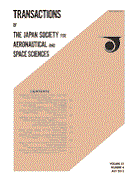
- Issue 6 Pages 231-
- Issue 5 Pages 205-
- Issue 4 Pages 139-
- Issue 3 Pages 109-
- Issue 2 Pages 47-
- Issue 1 Pages 1-
- |<
- <
- 1
- >
- >|
-
Wakako YAMAGUCHI, Toshiya YANASE, Jun ISHIHARA, Asuka NAKATANI, Taro H ...2022Volume 65Issue 3 Pages 109-115
Published: 2022
Released on J-STAGE: May 04, 2022
JOURNAL OPEN ACCESSIn this study, the characteristics of the decay in FLEET (femtosecond laser electronic excitation tagging) emission in the air captured during short exposure are investigated for the purpose of applying the FLEET technique to supersonic airflows. In the experiments, the FLEET signals from air in a static cell are captured using a CCD camera equipped with an image intensifier during a short exposure time of 20 ns. The results reveal that the decay in FLEET emission is almost independent of the location along the laser path, although pressure dependence of the emission intensity varies at each location owing to the Kerr effect. The results also reveal that the emission lifetime is dominated by intermolecular collision, on the basis of which the characteristics of decay in FLEET emission are simply modeled. The model reveals that the relaxation rate of the fleet emission increases linearly to the square root of the number density in the air.
View full abstractDownload PDF (1831K) -
Hayato KAWASHIMA, Keiichi KITAMURA, Satoshi NONAKA2022Volume 65Issue 3 Pages 116-122
Published: 2022
Released on J-STAGE: May 04, 2022
JOURNAL OPEN ACCESSTo accurately obtain a drag value for slender bodies (e.g., a rocket used in wind tunnel testing), base pressure and cavity pressure are required to be corrected to remove the effect of a sting. As the drag value significantly depends on the correction of the base/cavity pressure, attention should be paid, in spite of the absence of clear guidelines, to decide these two pressure values. In this study, to resolve this issue, wind tunnel test and numerical calculation results are used. As a result, first, we found that it is appropriate to measure the pressure near the base surface at four points and average them to estimate the base pressure. Second, the cavity pressure can be estimated the same as the uniform-flow static pressure even when shock waves are generated around the vehicle body. Based on these corrections, the total drag coefficient, CD, showed an effective agreement between the wind tunnel test and computational fluid dynamics. Furthermore, in absence of the sting, the drag value increased by 8%.
View full abstractDownload PDF (2492K) -
Haoxiang LIU, Satoshi SATOH, Yasuhiro SHOJI, Ichiro JIKUYA, Katsuhiko ...2022Volume 65Issue 3 Pages 123-133
Published: 2022
Released on J-STAGE: May 04, 2022
JOURNAL OPEN ACCESSIn this study, a singularity-free trajectory generation algorithm of the roof-type control moment gyro (CMG) system consisting of four CMGs is proposed. Under the condition that the total angular momentum is conserved at zero, by selecting the initial gimbal angles according to the direction of the angular momentum by the roof-type CMG system, the singularity is avoided in total angular momentum space, over the wide range of the magnitude of the initial gimbal angle except near the Z-axis. The effectiveness of the algorithm is confirmed by numerical calculations, and a PD-like control using the gimbal trajectory is proposed, which is also verified by numerical simulations.
View full abstractDownload PDF (4199K)
-
Kento YAMADA, Takahiro UCHIYAMA, Makoto UENO2022Volume 65Issue 3 Pages 134-137
Published: 2022
Released on J-STAGE: May 04, 2022
JOURNAL OPEN ACCESSDownload PDF (931K)
-
2022Volume 65Issue 3 Pages 138
Published: 2022
Released on J-STAGE: May 04, 2022
JOURNAL OPEN ACCESSDownload PDF (31K)
- |<
- <
- 1
- >
- >|